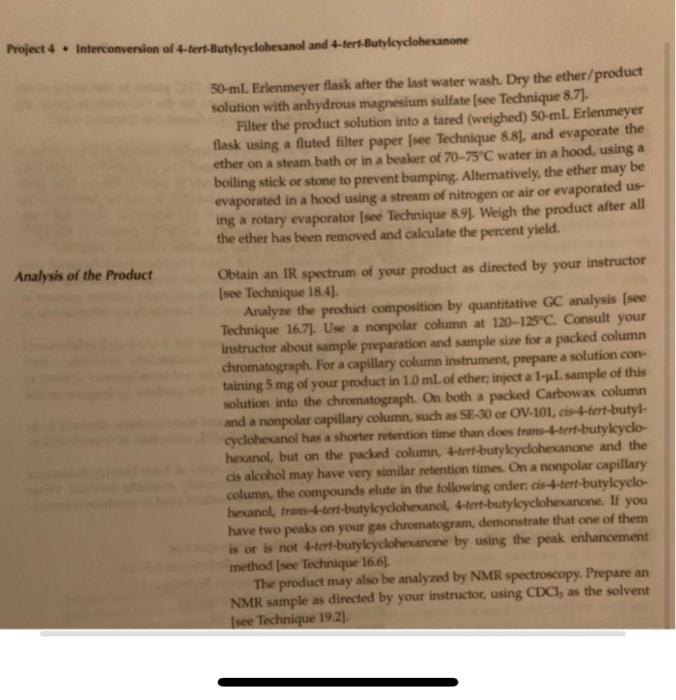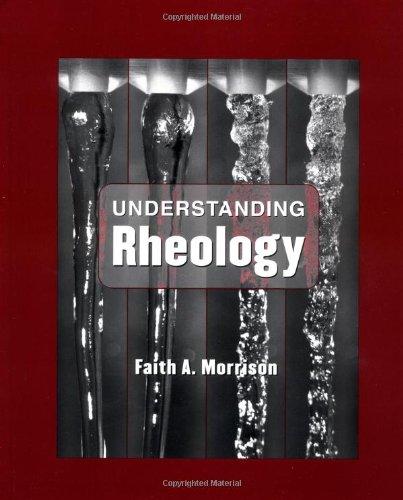Answered step by step
Verified Expert Solution
Question
1 Approved Answer
this is for Reduction of ketone lab can someone solve question 2. only correct answers please. let me know if any additional information is required
this is for Reduction of ketone lab can someone solve question 2. only correct answers please. let me know if any additional information is required 


Proportionally adjust the quantities of all reagents for the amount of ketone you synthesized in 4.1. Carry out the reaction in the Erlenmeyer flask containing your stored 4-tert-butylcyclohexanone. If you have less than 0.30 g of ketone, use the microscale procedure. Dissolve 0.80 g of 4-tert-butylcyclohexanone in 6.0 mL of 95% ethanol in a 50-ml Erlenmeyer flask. Slowly add 0.60 g of sodium borohydride. The mixture may become warm, so have a cold-water bath handy. Keep the reaction temperature between 25C and 35C. You may see a slow evolution of hydrogen gas during the reaction. After 15 min, check for completeness of reaction indicated by the disappearance of the 4-tert- butylcyclohexanone spot) by the TLC method used in Project 4.1 (see Technique 15) When the reaction is complete, add 10 mL of water and then care- fully add 3 M hydrochloric acid solution in 1-ml portions (2-4 mL may be needed) until the evolution of hydrogen gas becomes very slow or ceases. Then heat the mixture to the boiling point. Cool the mix- ture to room temperature or slightly lower. Add 15 mL of diethyl ether and stir the mixture. If a white inorganic solid forms, decant the liquid away from the solid into a separatory funnel. If no solid is present, simply pour the mixture into a separatory funnel. Rinse the Erlenmeyer flask with 5 mL of ether and add this rinse to the separatory funnel. Working in a hood, if possible, shake the separatory funnel to mix the phases and drain the lower aqueous layer into a labeled flask (see Technique 8.2). Pour the ether layer into another labeled flask. Return the aqueous phase to the separatory funnel and extract it a second time with 10 mL of ether. Remove the lower aqueous phase and combine the two ether solutions in the separatory funnel. Wash the combined ether layers with two 10-ml portions of water to remove most of the ethanol that remains dissolved in the ether layer. Transfer the ether solution to a dry Project 4. Interconversion of 4-tert-Butylcyclohexanol and 4-tert-Butylcyclohexanone 50-ml Erlenmeyer flask after the last water wash. Dry the ether/product solution with anhydrous magnesium sulfate (see Technique 8,7). Filter the product solution into a tared (weighed) 50-ml Erlenmeyer flask using a fluted filter paper (see Technique 8.8), and evaporate the ether on a steam bath or in a beaker of 70-75C water in a hood, using a boiling stick or stone to prevent bumping. Alternatively, the ether may be evaporated in a hood using a stream of nitrogen or air or evaporated us- ing a rotary evaporator (see Technique 8.9J. Weigh the product after all the ether has been removed and calculate the percent yield. Analysis of the Product Obtain an IR spectrum of your product as directed by your instructor (see Technique 18.4). Analyze the product composition by quantitative GC analysis (see Technique 16.7]. Use a nonpolar column at 120-125 C. Consult your instructor about sample preparation and sample sire for a packed column chromatograph. For a capillary column instrument, prepare a solution con taining 5 mg of your product in 1.0 mL of ether; inject a 1.. sample of this solution into the chromatograph. On both a packed Carbowax column and a nonpolar capillary column, such as SE-30 or OV-101, cis-4-tert-butyl- cyclohexanol has a shorter retention time than does trans-4-tert-butylcyclo hexanol, but on the packed column 4-tert-butylcyclohexanone and the cis alcohol may have very similar retention times. On a nonpolar capillary column, the compounds elute in the following order is 4-tert-butylcyclo hexanol, trans-t-tert-butylcyclohexanol 4-tert-butylcyclohexanone. If you have two peaks on your gas chromatogram, demonstrate that one of them is or is not 4-tert-butylcyclohexanone by using the peak enhancement method (see Technique 16.61. The product may also be analyzed by NMR spectroscopy. Prepare an NMR sample as directed by your instructor, using CDC, as the solvent I see Technique 19.21 Question 2: (1 pt total) Assume you isolated a total of 0.62 grams of 4-tert-butyl-cyclohexanol as a mixture of cis/trans isomers. Calculate the following: -0.25 pt % yield overall -0.25 pt % cis -0.25 pt grams of cis isomer present in the mixture -0.25 pt Attach your calculations as a supporting document. Full credit requires all work to be shown. You may do this problem either on the computer or handwritten 


Step by Step Solution
There are 3 Steps involved in it
Step: 1

Get Instant Access to Expert-Tailored Solutions
See step-by-step solutions with expert insights and AI powered tools for academic success
Step: 2

Step: 3

Ace Your Homework with AI
Get the answers you need in no time with our AI-driven, step-by-step assistance
Get Started


